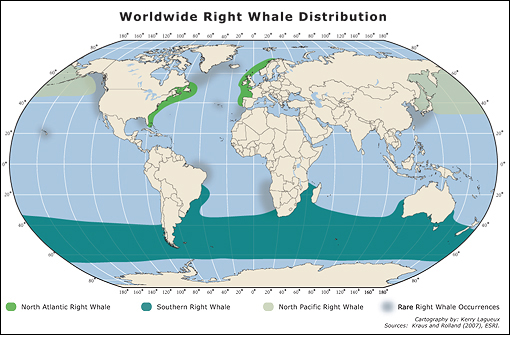


North Atlantic right whales were once found in both the western and eastern Atlantic Ocean. Only a few right whale sightings have been reported in the eastern Atlantic suggesting that, at most, only a small number of individuals remain in that area. The western North Atlantic population is estimated to number no more than 400 animals. They range from the Gulf of Mexico to Iceland although most of the catalogued sightings have been collected between northern Florida and the Canadian Maritimes. Recently, one known right whale traveled from the western North Atlantic to the eastern North Atlantic 1.

Known worldwide historical range of the three right whale species.
In the spring of 1999, a male right whale named Porter was seen in the Great South Channel east of Cape Cod, Massachusetts. Four months later and 4,428 km away, Porter was photographed by Karl-Otto Jacobsen in a fiord in northern Norway. Then, in March 2000, the whale was seen in Cape Cod Bay.
Porter was seen in the Great South Channel Critical
Habitat in 1999. Four months later, he was observed
again in a fiord in northern Norway - 4,428 km away
from his previous sighting.
Porter's journey across the Atlantic Ocean is a good example of the extensive travels some right whales undertake. Presently, most right whale surveys are conducted along the east coast of Canada and the United States and little is known about the whales in the more northerly parts of their range.
In Eastern Canada there are two right whale habitats designated as "Conservation Areas" by the Canadian government. In the summer and fall, right whales are found in the lower Bay of Fundy, east of Grand Manan Island, New Brunswick, and on the western Scotian Shelf in the vicinity of Roseway Basin between Browns and Baccaro Banks, south of Nova Scotia. More recently, there have been reports of right whales during the summer and fall in the Gulf of St. Lawrence, southeast of the Gaspé Peninsula between Chandler and Percé in Quebec and occasionally along the lower north shore near Anticosti Island and as far inland as Tadoussac, Quebec.
In Canada, right whales are known to aggregate in the conservation areas of the Grand Manan Basin in the lower Bay of Fundy and Roseway Basin south of Nova Scotia. Right whales have also been sighted in the Gulf of St. Lawrence mostly between Chandler and Perc�, on the continental shelf east of Nova Scotia and in the coastal waters of eastern and southern Newfoundland.
In addition to sightings of right whales on Roseway Basin, there are additional records on the eastern Scotian Shelf, primarily in the vicinity of Emerald Basin. These date back to the mid-1960s when whalers hunting fin and sei whales were still operating out of Blandford, Nova Scotia. Since this hunt ceased in 1972, there have been some right whale sightings reported in the late 1990s, but little research has been done in this offshore area. A few right whales have also been reported in the coastal waters of eastern and southern Newfoundland 2.

1 Jacobsen, K.-O., M. Marx, and N. Øien. 2004. Two-way trans-Atlantic migration of a North Atlantic right whale (Eubalaena glacialis). Marine Mammal Science 20:161-166.
2 Knowlton, A. R., J. Sigurjónsson, J. N. Ciano, and S.D. Kraus. 1992. Long-distance movements of North Atlantic right whales (Eubalaena glacialis). Marine Mammal Science 8:397-405.

